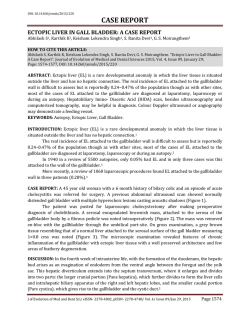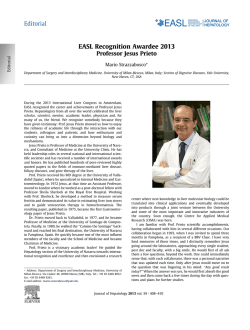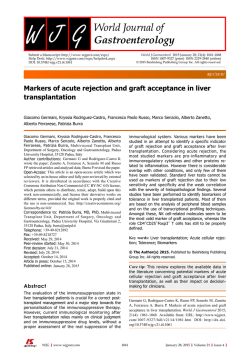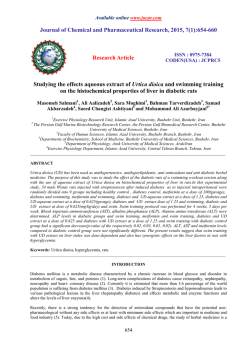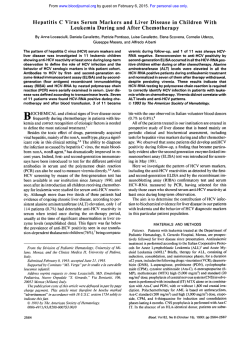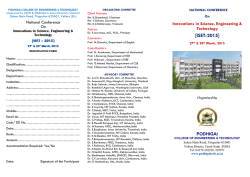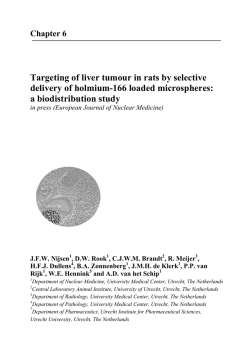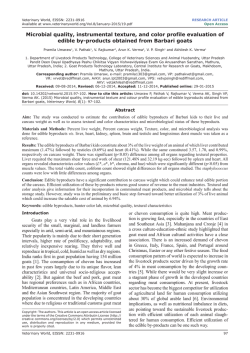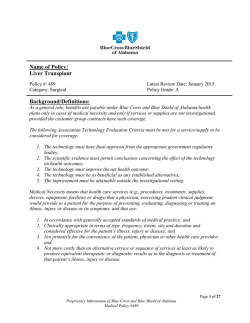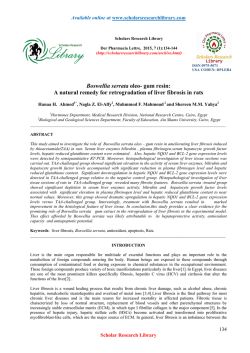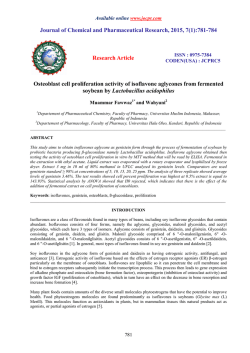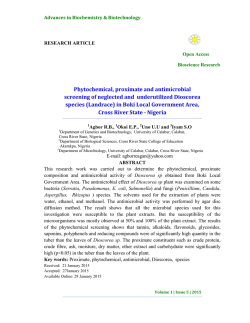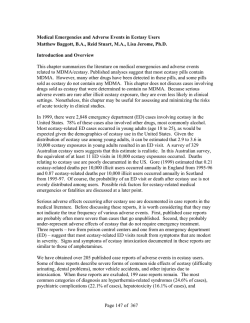
Hepatoprotective activity of Averrhoabilimbi fruit in acetaminophen
Available online www.jocpr.com Journal of Chemical and Pharmaceutical Research, 2015, 7(1):535-540 Research Article ISSN : 0975-7384 CODEN(USA) : JCPRC5 Hepatoprotective activity of Averrhoa bilimbi fruit in acetaminophen induced hepatotoxicity in wistar albino rats Thamizh Selvam N., Santhi P. S., Sanjayakumar Y. R., Venugopalan T. N., Vasanthakumar K. G. and Swamy G. K. National Research Institute for Panchakarma, (Central Council for Research in Ayurvedic Sciences, New Delhi Department of AYUSH, Ministry of Health and Family Welfare, Govt. of India), Thrissur, Kerala, India _____________________________________________________________________________________________ ABSTRACT The present study was taken up to evaluate the hepatoprotective activity of Averrhoa bilimbi fruit in wistar albino rats intoxicated using acetaminophen. The extract was administered at two different concentrations 250 mg/kg.b.wt and 500 mg/kg.b.wt as lower and higher dose respectively. Silymarin (100 mg/kg.b.wt/) was used as standard positive control. The liver marker enzymes serum gluatamate oxaloacetate transaminase (SGOT), serum glutamate pyruvate transaminase (SGPT), Alkaline phosphatise (ALKP) were found to be two fold increased in the disease control group, and pre-treatment with A. bilimbi inhibited the increase of these enzymes in serum. The histopathology studies on the tissues of liver, kidney and heart showed safety and efficacy of the test extract. The present study revealed that A. bilimbi fruits have significant hepatoprotective activity. Key words: Hepatoprotective activity, Averrhoa bilimbi, acetaminophen intoxication, liver marker enzymes _____________________________________________________________________________________________ INTRODUCTION Liver is one of the chief sites for intense metabolism and excretion. It is involved with almost all the biochemical pathways for growth, fighting against diseases, supply of nutrients and energy provision. But the liver functions are greatly altered and affected due to varied reasons like environmental toxins, poor drug habits, alcohol and other ailments [1-3]. So, the liver diseases are one of the leading issues in the world today. The plant Averrhoa bilimbi commonly known as bilimbi, is essentially tropical tree, less resistant to cold. The bilimbi tree is long lived, reaches 5 to 10 mt in height. The leaves are alternate, and cluster at branch extremities. Flowers are found on the trunk and branches. Fruits of bilimbi are too sour to eat raw [4]. The uncooked bilimbi is prepared relish and served with rice in natives of Kerala, India. EXPERIMENTAL SECTION Plant Material The fruits of A. bilimbi were collected from Western ghat region of Kerala (Thrissur and Palakkad) and the authentication of the plant was done in the Pharmacy Division, National Research Institute for Panchakarma, Thrissur. Preparation of Extract The fresh fruits were taken (100 gm) and crushed using mixer grinder, the juice was filtered through Whatman filter paper No.7. The clear filtrate was obtained and was stored in the 4-80 C for experimental purpose. 535 Thamizh Selvam N. et al J. Chem. Pharm. Res., 2015, 7(1):535-540 ______________________________________________________________________________ Chemicals and Reagents: Chemicals and Reagents of make Transasia, Bayer and Spinreact India were used for the present study. Phytochemical Studies The phytochemical analysis of the test extract was carried out as per the standard protocol [5-8]. Animal Experiment: The animal studies were carried out in the National Research Institute for Panchakarma, Cheruthuruthy as per CPCSEA guidelines and with the approval of Institutional Animal Ethical Committee. Six to seven months old Wistar albino rats weighing 150-200 gm were used for the experiment. The animals were fed with standard laboratory pellet chow (Amrit, Bangalore) and given water ad libitum. All rats were clinically healthy. The animals were randomly divided into five groups of six animals each and the standard protocol was used [9-10]. The fruit extract of A. bilimbi, was administered at two different concentrations (250 and 500 mg/kg body weight) as lower dose (Group IV) and higher dose (Group V) through orally for the period of ten days in test groups. The disease group (Group II) and test groups received single dose of Acetominophen (paracetamol) at 2.5 gm/kg body weight. The control group (Group I) received distilled water throughout the experiment and standard group (Group III) received silymarin 100 mg/kg body weight for the experimental period. The animals were fasted for 24 hrs on 10th day of the experiment and blood sample was collected. The biochemical parameters including liver marker enzymes were assessed in the blood samples of the test groups, control groups and disease groups [11-14]. At the end of the experiment, the animals were sacrificed under anaesthesia using diethyl ether and the tissue samples of liver, kidney and heart were collected for evaluation of histopathological changes in tissue level among all the experimental groups. Statistical Analysis The data were expressed as mean ± SEM and statistically analyzed by one way ANOVA. RESULTS The phytochemical analysis of the fruit extract showed the presence of carbohydrates, flavonoids, phenols, glycosides and amino acids (Table 1). Table 1 : Phyto-constituents of fruit juice of A. bilimbi PhytochemicalAnalysis Extract of Syzigium jambos Carbohydrate +++ Phenols +++ Flavonoids +++ Tannins + Steroids Terpenoids Alkaloids + Glycosides ++ Saponins Aminoacids +++ +++ Very strongly present ++ strongly present + Present - Absent Hepatoprotective Activity The present study had been attempted to demonstrate the role of hepatoprotective activity of fresh juice of Averrhoa bilimbi in the experimental animal system. The liver marker enzymes Serum glutamate oxaloacetate transaminase (SGOT), serum glutamate pyruvate transaminase (SGPT) and alkaline phosphate levels were measured in the serum samples of all the experimental groups. These liver marker enzymes were found to be increased nearly two to three fold in the acetominophen intoxicated disease control animals comparing with healthy control group. The results also showed that there is a significant (p < 0.05 and p < 0.01) decrease in the in SGOT, SGPT and ALKP levels in the A. bilimbi treated groups, when compared with the disease control. As there is a greater level of efficacy in the higher dose group (500 mg/kg. b.wt) comparing with lower dose, it is predicted that the efficacy of the extract is found to be dose dependent. It was also observed that the efficacy of the extract is comparable (Table 2 and Figure1-2) with standard drug silymarin. The histological study of liver is also supporting these biochemical and clinical parameters. The histology of liver tissues of disease control group showed extensive areas of haemorrhage and necrosis in the liver parenchyma and vacuolated cytoplasm in hepatocytes. Kidney tissues of the same group showed oedema and showed vacuolation in the lining of epithelial cells. The extract treated groups showed 536 Thamizh Selvam N. et al J. Chem. Pharm. Res., 2015, 7(1):535-540 ______________________________________________________________________________ improved and apparently normal architecture of the liver, glomeruli and myocardial tissues. (Figure 3-8). All these biochemical diagnostic parameters and histological tissue analysis well evidenced the hepatoprotective activity of Averrhoa bilimbi in experimental animal. Table 2. Liver marker enzymes level in the serum samples of experimental animals Liver marker enzymes (IU/L) SGOT SGPT ALP Healthy Control 133.56 ± 21.61 69.75 ± 8.98 91.82 ± 13.67 Disease Control 358.0 ± 22.14* 293.86 ± 10.19* 266.77 ± 9.75** * * Standard Drug 164.91 ± 23.85 74.58 ± 11.77 117.36 ± 16.47** A. bilimbi L.D 266.78 ± 14.55* 160.80 ± 16.74* 188.8 ± 35.8* * ** A. bilimbi H.D. 233.70 ± 21.14 113.95 ± 14.27 139.29 ± 14.42** Values are mean ± SEM, n=6 animals in each group. *p < 0.05, **p<0.01 when compared to disease control Experimental Groups Figure 1. Status of lipid profile in the A. bilimbi extract administered animals 180 Lipid Profile 160 Units in mg % 140 120 100 80 Cholesterol 60 Triglycerides 40 20 0 Healthy Control Deiase Control Standard Group A. bilimbi L.D A. bilimbi H.D Experimental Groups . Figure 2. Albumin, bilirubin and total proteins levels in the blood samples of A. bilimbi treated experimental animals 9 Biochemical parameters 8 Units in gm % 7 6 5 4 Albumin 3 Total protein 2 Total bilirubin 1 0 Healthy Control Deiase Control Standard Group A. bilimbi L.D A. bilimbi H.D Experimental Groups . Figure. 3. (45X) Acetaminophen treated rat liver showing extensive areas of haemorrhage and necrosis in liver parenchyma. Hepatocytes showed vacuolated cytoplasm. Collection of inflammatory cells and siderophages observed 537 Thamizh Selvam N. et al J. Chem. Pharm. Res., 2015, 7(1):535-540 ______________________________________________________________________________ Figure 4. (45X) Glomeruli showed oedema. Renal tubules showed vacuolation of the lining epithelia cells. Interstitial tissue showed focal collections of inflammatory cells and areas of haemorrhage Figure 5. (45X) Section of heart showing normal endocardium and myocardium Figure 6. (45X) A. bilimbi treated at 500 mg/kg. Wt showed apparently normal architecture of liver Figure 7. (45X) Glomeruli of test drug treated group showed normal histology. Interstitial tissue appeared normal 538 Thamizh Selvam N. et al J. Chem. Pharm. Res., 2015, 7(1):535-540 ______________________________________________________________________________ Figure 8. (45X) Heart tissues showed normal endocardium and myocardium DISCUSSION The literature review revealed that traditional healers are using this plant for various ailments and natives of Kerala and some part of Tamil Nadu are using this fruit as food ingredient. The present study was designed and carried out scientifically to evaluate the hepatoprotective activity of A. bilimbi fruits. Liver damage induced by Acetominophen (generally known as paracetamol) is one of the commonly used model for the screening of hepatoprotective drugs [15-17]. Paracetamol is one of the basic medicines used as an antipyretic agent, which is safe in therapeutic doses but it can produce fatal hepatic necrosis in man and animals [18-20]. The rise in serum SGOT, SGPT, ALKP levels has been attributed to the damaged structural integrity of liver. It is because of, as these enzymes are belonged to the cytoplamic location of the liver cells and they are released into circulation after cellular damages [21-22]. Paracetamol induces hepatotoxicity at higher dose by metabolic activation; therefore, it selectively causes toxicity in liver cells maintaining semi-normal metabolic function [23-25]. The liver protective property of the A. bilimbi was well proved when the elevated levels of liver markers enzymes SGOT, SGPT, ALKP and bilirubin levels was brought to down significantly and the efficacy was almost comparable with silymarin. The histology analysis on the liver, kidney and heart tissues of the experimental animals strongly evidenced that there is safety and efficacy in the A. bilimbi treated animals. In conclusion, from the overall result of the study it could be inferred that Averrhoa bilimbi fruit showed the significant hepatoprotective activity. It is assumed that the high contents of phenol group compounds, flavanoids and amino acids may be attributing for the medicinal property of the A. bilimbi. Further research on the plants could be extended for the isolation and structure determination of the principle compounds for this property. Acknowledgement Authors are thankful to the Director General, CCRAS, New Delhi and other Staff members of NRIP for their kind support and encouragement. REFERENCES [1] Sharma B, Sharma UK. International Journal of PharmTech Research. 2009;1 (4):1330-1334. [2] Kshirsagar AD, Mohite R, Aggarwal S, Suralkar UR. Asian Journal of Pharmaceutical and Clinical Research. 2011;4 (3):1-8. [3] Deepak KD, Veerendra CY, Siva SN, Tirtha G, Rajalinga D, Pinaki S, Bhim CM, Tapan KM. Tropical Journal of Pharmaceutical Research. 2007; 6(3):755-765. [4] Warrier PK, Nambiar VPK, Ramankutty C. Orient Longman Publications. 2002; 1:224-226 [5] Maluventhan Viji, Sangu Murugesan. (2010). Journal of Phytology. 2;1:68-77. [6] Hassan SW, Umar RA, Lawal M, Bilbis LS, Muhammad BY and Dabai YU. (2006). African journal of Biotechnology. 5;18:1602-1607. 539 Thamizh Selvam N. et al J. Chem. Pharm. Res., 2015, 7(1):535-540 ______________________________________________________________________________ [7] EL- Olemyl MM, AL-Muhtadi FJ, Afifi AA. (1994). Experimental phytochemistry. A Laboratory manual college of Phramcy, King Saud University. King Saud University Press. 1-34. [8] Trease GE, Evans WC. (1978) A textbook of Pharmacognosy. 11th Edition. Bailliere Tindall Publication. London. 530. [9] Gupta AK, Misra N. (2006) Am J Pharmacol Toxicol 1:1-7. [10] Thamizh Selvam N, Venkatakrishnan V, Dhamodharan R, Murugesan S, Damodar Kumar S. (2013) . AYU 34:3:305-308. [11] Girish C, Koner BC, Jayanthi S, Rao KR, Rajesh B, Pradhan SC. Indian Journal of Medical Research. 2009; 129 (5): 569-578. [12] Gupta AK, Neelam M. American Journal of Pharmacology and Toxicology. 2006; 1 (1):17-20 [13] Thamizhselvam N, Anjusha P, Sanjayakumar YR, Salini KC, Venugopalan TN. International Research Journal of Pharmacy. 2011; 2(11):116-118. [14] Roy CK, Kamath JV, Asad M. Indian Journal of Experimental Biology. 2006; 44 (4): 305-311. [15] Mitchell JR. Jollow DJ, Potter WZ. Gillettee JR, Brodie BN. Acetominophen induced hepatic necrosis. I. Role of drug metabolism. J Pharmacol. Expl. Therap. 1973; 187: 185-194. [16] Kuma S and Rex D. Arch. Inter. Med. 1991; 151: 1189-1191. [17] Erikson L, Broome U, Kahn M, Lindholm M. J Inter Med. 1992; 231: 567-570. [18] Asha VV, Akhila S, Wills PJ, Subramoniam A. J Ethnopharmacol. 2004; 92: 67-70. [19] Kumar G, Banu SG, Pappa VP, Sundararajan M, Pandian RM. J Ethnopharmacol. 2004; 92:37-40. [20] Visen PKS, Shukla GK, Patnaik and Dhawan BN. J Ethnopharmacol. 1993; 40:131-136. [21] Boyd, EH, Bereczky GM. British Journal of Pharmacology. 1996; 26:606-614. [22] Dahlin D, Miwa G, Lu A, Nelson S. Proc. Natl. Acad,. Sci. 1984; 81:1327-1331. [23] Moron MS, Depierre JW, Mannervik B. Biochem. Biophys Acta. 1979; 582: 67-78. [24] Singh A and Handa SS. J Ethnopharmacol. 1995; 49: 119-126. [25] Gupta AK, Chitme H, Dass SK, Misra N. J Pharmacol Toxicol. 2006; 1: 82-88. 540
© Copyright 2024
